Food gardens have been an existing self-provisioning practice in families for centuries now.
Since their first appearance in the urban context in 1760, it has only been gaining more popularity and importance.
During the first world war when the government encouraged US citizens to start gardens.
In the 1930s, when the Great Depression hit hard, people had to turn to planting their own food to escape poverty and starvation.
Nowadays, times are getting more and more unstable. Vegetable gardens are not only great for surviving in times of crisis but can also provide you with fresh foods and scarce elements in your region.
It is also considered a relaxing activity, either to spend some quality time with your family or to do by yourself.
As a prepper and gardener, being able to produce everything you consume within a whole year will save a lot of money.
Related: How Was Your Gardening Season?
To start a vegetable garden, start by designing your space. Choose a spot that is spacy enough, depending on the quantity and size of what you are choosing to plant.
The spot should also be getting a fair amount of sunlight during the day (at least 8 hours), as most vegetables need a lot of direct sun to best harvest.
Next, decide on what to plant. Pick something relatively easy to grow, such as tomatoes, cucumber, or even spinach.
Take into consideration the space you have, the time of the year, and of course, your needs and preferences. For more helpful information, check out this guide on how to make a year-round self-sustaining garden.
Why You Should Put Plastic Forks In Your Vegetable Garden
This is my favorite gardening tip. Plastic forks could be a multifunction tool in your garden. I’ll mention here some of their uses.
Keeping Animals Away
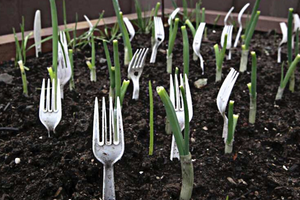 Your pets keep ruining your garden, digging the soil, running over your vegetables.
Your pets keep ruining your garden, digging the soil, running over your vegetables.
Plastic forks are great to keep pets and wild animals away. Just stick them in the ground of your garden, placing them some inches apart to prevent animals from stepping over them.
Keeping Plants Still
Getting your plants to stay down can be a struggle. Plastic forks can help you with that.
Insert the tines of the fork into the ground around the plants to hold properly and push down. It will keep your vegetables and plants in place for you.
Related: The 24 Highest Calorie Vegetables for Your Survival Garden
Remember to adjust the forks from time to time to make sure that they are still securely planted. If your garden is small, regular plastic forks will do the job, but as you get more plants, you may want to consider switching to garden forks for a better grip.
Labeling Plants
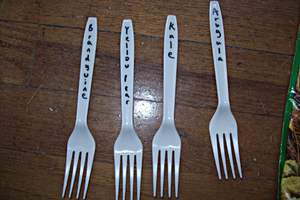 Forks can also be used as a cheaper labeling alternative for your plants.
Forks can also be used as a cheaper labeling alternative for your plants.
There is a variety of different shapes and sizes to choose from.
Just find the ones you like, and write over them to keep track of your plants. You can even color them.
Building Borders And Fences
Another way to use forks in your garden is to wash them and line them at the edges of your beds. It will help you create sections in your garden to separate your different plants and stay within the lines when gardening.
⇒ Do You Know Why You Should Never Put A Tall Fence Around Your House?
Having a forks fence around your vegetable garden will also help keep the rabbits and squirrels away.
More Gardening Tips
Aside from plastic forks, another golden tip is to have good soil. In gardening, having healthy soil is crucial. Your soil has to have nitrogen, phosphorus, and potassium, elements that are essential for your plants’ growth.
Your vegetables will also need for it to contain compost and organic material such as bark and leaves. These two fertilize the soil and help it retain moisture. The best soil should be neither compacted nor sandy. It should be easy to dig.
Don’t Over Fertilize
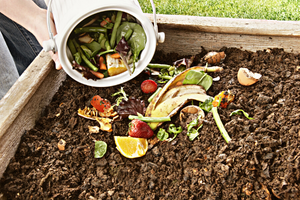 Many people make the mistake of overusing nitrogen, thinking it will promote faster growth. They usually just end up with a small harvest and fewer vegetables.
Many people make the mistake of overusing nitrogen, thinking it will promote faster growth. They usually just end up with a small harvest and fewer vegetables.
What you can do instead is to opt for organic fertilizers, such as compost for your soil.
As mentioned before, good soil is key. It will provide your plants’ roots with the all nutrients and oxygen they need to thrive, resulting in a healthy and productive garden.
Be Careful With Watering
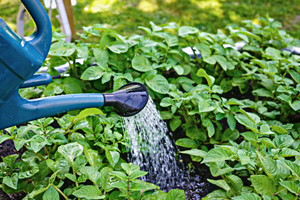 Most vegetable plants only need one inch of water per week.
Most vegetable plants only need one inch of water per week.
This doesn’t mean to only water them once.
Except for when seedling, plants do best when watered 3 times a week, including any rainfall.
Water your plants either in the early mornings or evenings, avoiding the period of the middle of the day to prevent water loss due to evaporation.
Use Mulch
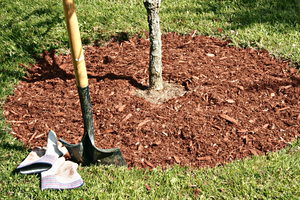 Adding mulch is a great water-conserving technique.
Adding mulch is a great water-conserving technique.
Having a layer of any organic mulch around your plants and over the irrigation lines will reduce evaporative moisture losses, protecting the soil and helping it stay cooler in the summer and warmer in the winter.
Be careful though. Some mulches contain high levels of harmful chemicals. So make sure you check the source of it before using it in your garden.
Lastly, check on your plants regularly. You must pay close attention to your plants, that way you always know if any issues were to come up.
Are they getting enough water, are they exposed to the sun long enough, and are they having a nutrition issue?
Checking the plants for any color changes, droopiness, and leaning, as well as noticing how fast they grow will help you stay alert and adjust your methods according to your gardens’ needs.
If you use all the tips mentioned above, be sure you will be set up for a good start on your gardening journey.
As a prepper, you know that preparation is key and it is no different when it comes to gardening.
If you haven’t yet, just start, be patient, and learn as you go. You will be more than ready for any crisis.
You may also like:
 The Most Powerful Non-Lethal Weapon Against Invading Rioters
The Most Powerful Non-Lethal Weapon Against Invading Rioters
A Kit That Has Everything You Need To Start Your Medicinal Herb Garden (Video)
Places To Avoid: Where Looters Will Strike First When SHTF

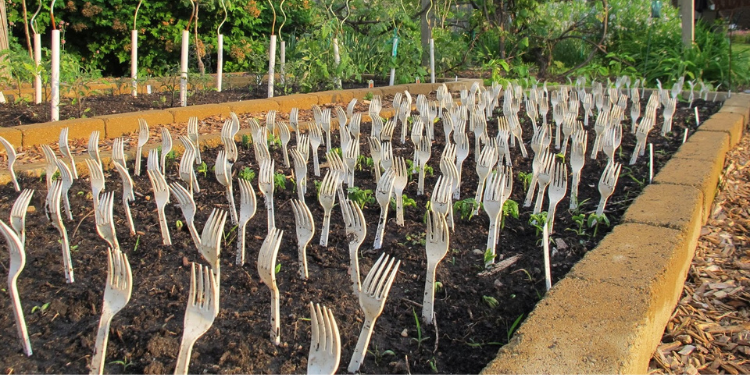













thats what i want plastic leeching in my food
Hunter Biden aka Raven aka Ya way highway.
Has anyone ever told you that you will never be relevant?
You ok up Chuck?
My wife works at a landscape nursery. BE AWARE that lots of mulches contain dyes. Since you cannot know the chemical makeup of the “paint-like” dusts that are coloring some mulches, Ask first for non-dyed mulch. All mulches rot out within several years and for planters adjoining foundations they will rise too high (for building codes). We have often put down “weed barrier” under mulches, but weeds grow right through it. You would be lucky if you kept most weeds out for a full two years, plus rolls of weed barrier can get expensive. When weeds grow it is easiest to pull them out inside the weed barrier and lay down new weed barrier, then rake any remaining mulch over it again. If you leave old weed barrier in the ground, you will pay a price later when you try to put a shovel in the ground and have difficulty. A few years ago we used a thick-mil plastic sheeting about 12-18 inches from plants (for watering). These keep down weeds real good, but often the mulch if it is too thin and will show the plastic through the mulch. BYW, thick mil plastic on the most rainy or drainy sides of your house will keep moisture from wetting basement walls. I put 36-inches of heavy mil plastic around my 1936 built Old home to keep my basement dry. Doing this is called “A Ground Gutter”, since it is in ground, under mulch (or other) and it drains water away from the foundation. If you “overlay them” from the house, do it like your roof shingles (so rain doesn’t run over one sheet and under the next one. My answer for weeds today after “messing around for years with planter weeds” is to let all weeds grow and weekly cut them at ground level with a weed-whacker. From a distance, the area still looks nice. It is a quick “clean up”. We leave the debris right where it falls (it fertilizes the soil); and I often spot edible weeds that I can pull and intentionally replant elsewhere. If you want lots of weeds on your property, put up a bird feeder during winter time. Expect to see birds, squirrels, and rabbits — you may never know when that feeder has trained these critters to visit your yard (like a lure)…and especially when you may be hungry.
Hello, Weeds come from above not below,If you put weed barrier down on clear ground it will help with weeds that come from ground darker thicker the better, Now your new weeds will come from the top air borne bird poop wherever they come from and left unattended will root though your weed barrier and grow if your weed barrier is thin. Just my thoughts, Thank you.
I turned my soil, placed weed block down, covered with 2 layers of cardboard (corrugated), then 2 inches of mulch.
If weeds can grow through all that then maybe I need to call Guinness…. LOL
You can spot kill weeds with straight vinegar.
Spray only the weeds.
A great article. Maybe this will help keep the elk away from my garden.
Other than the hilarity of the picture with the forks sticking up, it is a really good article.
Here, I use a matching set of plastic cutlery to set the table sort of speak in my window boxes that are filled with alpine strawberries, and I also stick one in the soil to mark each herb pot. Adds new fun design to the standard phrase “kitchen garden”.
Elk, deer, cats, rabbits, dogs, neighbors….. are all common garden pests. I plant in the spaces of 16 all matching pallets. Not chemically treated. 2 rows of 8 pallets. I pull weeds or plant close with smaller edibles for the rest of the garden. Three sisters plantings stay pretty weed free for corn/ climbing beans and squash or pumpkins. The thick growth stops most weeds. So do the pallets and in my desert country they help hold in moisture. I plant strawberries and onions together. Planning to add asparigus to the bed this year. Winter mulch against the high mountain winter cold.
How does a gardener keep moles out of a veggie garden. The moles love potatoes.
You can buy an ultrasonic device to drive them out.
Or mole killer poison if that is your preferred method but anything eating the dead moles will be poisoned too.
Buy some juicy fruit, cut each stick into 4 strips. Put these strips down thru the dirt into their passageways, not the entrance/exit holes. They love it, but can’t digest it, so they die, but it doesn’t poison them so as to put farm cats and owls at risk.
A hungry house cat. My cat kills the moles for sport, because she doesn’t eat them. She’ll only eat the heads of the mice for some reason (perhaps they’re a crunchy juicy delicacy) after tormenting the hell out of them. I prefer she kill the mice, but rodents are rodents, I guess. So keep the cat outside and don’t give her much of the kitty junk food (i.e., bagged commercial cat food).
Just to mention, there were no plastic forks in 1760; not sure there were any in 1930?
I’m pretty sure it was not stated in the article that people used plastic forks in their garden in 1760 or 1930. It merely said that food gardens first appeared in an urban context in 1760, and that in 1930 people turned to growing their own veggies, emphasizing on the importance of gardening.
Cats like to poop right below my window at night. It builds up, smells bad and it is extremely difficult to get them to stop. I use the cat repelling spray, and mouse traps to keep them away but that does not deter them much. I will have to try the plastic forks also with cheap mouse traps set between them.
Mothballs may work, also.
I had a Ford F150 with the transmission removed. Cats got up in through the shifter hole and peed all over the seat. It was hilarious. I had too many irons in the fire and sold the truck anyways, but I will never forget that smell.
Get hardware cloth and cover the ground where they poop.
Cats generally won’t poop unless they can dig a hole.
That may be true, but we definitely have a neighborhood cat that just poops everywhere without covering it up. =P
Buy bulk ground chilies. The cats won’t want to clean the pepper off their paws.
Loralee, when the cat doesn’t cover his poop, it’s often a sign that he’s establishing dominance. Especially if there are other cats also pooping on that spot.
You can try strewing bunan urine in the spot or coyote or wolf urine and see if that has them seeking out a different place.
Call the local animal control to live trap them. They should pick them up. Maybe the neighbor who let them roam will keep them closer after a kitty jail bond is posted.
Pecan shells will deter cats. I get them from places that shell pecans . Put it down in flower beds for mulch and cats hate it in their paws. They will use your neighbors flower beds for a potty instead.
I’ve never known anything short of a .177 / .22 to keep tree rats (squirrels) out of anything.
It’s also the most satisfying of all pest control methods.
I really don’t see how plastic forks will work to keep the animals in my neighborhood out of the garden. For instance, the chickens like to dig and would dig them up. That would definitely put the cabash on keeping other animals out.
It would take years for me to accumulate enough forks to even start this. Then my pup would consider it a great game to pull them all up Seeing as he definitely considers it HIS job to keep deer (does an excellent job), squirrels (ditto) and birds, including my free ranging chickens (better with larger birds, not so good with smaller ones).. I’ll leave him to it.
My ground is like cement: hard clay with gravel and rocks and I’m far from any other gardeners, so no moles or other tunnelers, I mostly do containers/cloth pots but am building up patches of soil by putting down a layer of cardboard, a layer of ‘home’ created compost well turned by those chickens (I don’t need to ‘turn’ it, but do need to periodically rake it up back into its ‘pile’, a layer of wood chips provided by the local electric companies, etc, when they are clearing trees and branches from obstructing the lines in the ‘neighborhod’, a layer of ‘cold’ manure from my organically fed meat rabbits, and a layer of leaves..mostly oak and maple… repeat.
I’ve been grateful that I did not knee jerk pull every weed, seeing as I’ve found that there are very few invasives here and that virtually everything ‘native’ AND many of what invasives there are on my land… are edible and/or medicinal.. It’s been great fun learning to identify them in their various stages (I’m already starting to ‘graze’ as I putter around as many are starting to come up for spring) and learn what they are good for ‘medicinally’, how to harvest and prepare them for such uses. I can’t tell you how many times I’ve thought ‘I don’t see any use for THAT one’…and someone in the community will say, ‘break it off and put the sap on poison oak’ or such.. so I’ve gotten to the point where my best ‘weed control’ is harvesting it for food or remedies.. for some of those… my bane is stickers and foxtails that get all over my dog… I pull to my hearts content now that I have identified them in their pre-seed/sticker stages and leave the young greens there to mulch around currently more preferred specimens… such as some of the thistles whose roots are edible are so prolific that I don’t worry about how many I pull… nor the one currently not identified as edible or useful. My rabbits love blackberrry vines,leaves, thorns ,and all, which keeps those at bay, and get the young oak and maple leaves…. and many of the broad leaved ‘sticker’ grasses before they seed… which saves some on feed and gives them a more diverse diet..
BUT many ‘weed’ seeds that are buried or ‘plowed’ under, will remain viable for decades, though they may need a few good freezes or fire to ‘scarify’ and germinate.. every year I’ve been here, something new comes up.. keeps it interesting…
what do you do about ants?
Sugar & borax. Mix equal parts and spread it around.
Cheap store bought cinnamon for ants..
Kill the fire ant but ants are very good at keeping bugs away and are super pollinators.
stay sharp
So forks … for “fences”, keeping animals out and dividing the garden? As a hardcore gardener myself, I have to ask … were you desperate for material?
I have used newspaper under my mulch, shredded tree branches, with no problems. I used entire sections, opened up, and overlapped with about 4″ of mulch. It grays out, doesn’t blow away, and any weeds are easy to pull out. No color ink if possible. The mulch degrades after a couple years so I just topped it off but it makes great soil too.